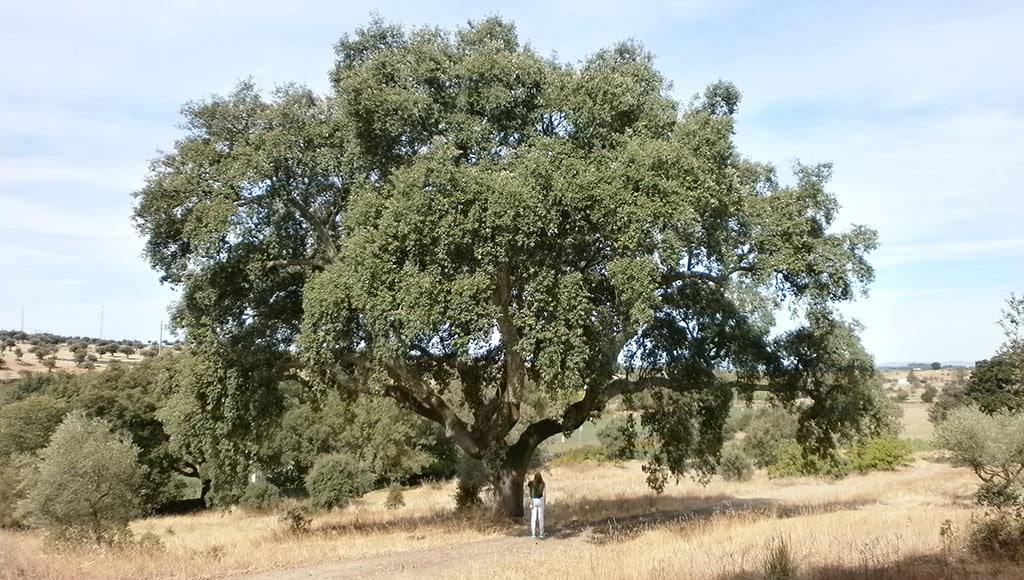As you uncork a wine bottle to relax with a refreshing glass of wine or, as you put your glass down on a cork coaster, have you ever stopped to think about this incredibly versatile natural material?
I had seen a few things made of cork, but it was only when I decided to research this article that I became aware of just how amazing cork is as a material for the production of a huge variety of goods. I was even more excited when, to my surprise, I came across a shop in Silves dedicated entirely to cork-made goods. Despite living here for years, I had never been in a cork shop!
I thus spent an enjoyable hour chatting to Ana Luca who has worked in the shop since it opened in 2016. Shoes, aprons, jewellery, handbags, ties, souvenirs etc. all made of various thicknesses of cork were fascinating to explore. I learnt that cork is also an eco-friendly, sustainable option for insulation in buildings and that it is used in musical instruments and sports equipment.
Portugal’s cork forests were planted back in the 13th century, but cork only became important commercially in the 17th century when it began to be used in wine bottles to replace the wooden stoppers and oily rags previously used. Corks provide a much better seal, significantly reducing oxidation and allowing for more controlled and extended aging, leading to the development of more flavours.

Did you know that Portugal is the world’s top producer of cork, accounting for over 50% of sales? Of the 100,000-plus tons produced annually, 70% of the cork is used for the production of wine bottle corks. Last year, cork sales increased by 8.6% to €2,020 million and half was from the stoppers!
France is the top cork importer followed by Spain and Italy.
Since 2012, the cork tree has been classified as Portugal’s national tree and there are over 730,000 hectares of cork oak forests, the majority of which are in the Alentejo and Algarve.
However, to grow a cork business, you have to be very patient for you cannot strip the first irregular ‘virgem’ cork from a tree until it is 25 years old. The stripping is known as ‘saca da cortiça’. Then you have to wait another nine years to harvest the ‘secondary’ cork. A further nine years have to pass for the stripping of the third cork, which is by then the necessary quality for the production of the wine bottle corks.
Stripping subsequently occurs every nine years, between May and August, when the bark is less attached to the trunk. Most cork trees live 150 to 200 years; therefore, one tree can be only stripped less than 20 times. As you drive around the countryside, you may see stripped cork trees standing half ‘naked’ with a reddish colour trunk which later changes to brown as the cork regrows. The white paint markings on the trees denote the year the cork was stripped, and this always remains visible as the cork grows from the inside out.
It is a biological wonder that the cork oak bark can be taken off the tree without it dying as any other tree would die without its bark. This ancient stripping process is done by highly skilled workers who chop off the cork bark without damaging the tree trunk. Any damage could lead to killing the tree.

On average, each year a tree harvest produces between 40 to 60 kilos and, to get an idea, 45 kilos can produce 1,400 wine bottle corks.
Once harvested, the cork is left in carefully assembled piles to dry out for six months before being taken to the processing factories, most of which are up north. The cork then goes through a series of processes that involve it being boiled to remove impurities and to make it softer and pliable.
After being cut into sheets, it is left to dry once more for various months and it is then finally sorted by quality. Only the highest quality cork is chosen for making wine corks and the rest is used for cork goods and insulation.
There is a cork factory in Silves that makes insulation panels and when the wind is blowing in the direction of Lagoa, we can smell a distinctive burning smell from the smoke emitted from the factory. I do not mind the smell, but there have been many understandable complaints from residents living nearby who find the daily smell overwhelming.

Portugal’s cork oak forests have been recognised as a UNESCO World Heritage Site for their cultural and ecological significance and the cork production is highly regulated to protect them. Apart from their contribution to the economy, the cork trees also contribute significantly to environmental sustainability.
They provide a unique ecosystem to support other animals and plants, and their roots improve soil conditions and water flow. The trees also absorb and store carbon dioxide, thus help to mitigate climate change and, very importantly, they also provide a fire barrier for they do not burn easily, which is crucial in Portugal’s summer tinder conditions.
The cork capital of the world is in Coruche, in the municipality of Santarém, and it is the epicentre of Portugal’s cork production where visitors can go on an immersive visit from the forest to the factories. However, there are many towns throughout Portugal where you can see the impact that cork production has on the local economy and see the amazing ancient trees and cork production process.
A simple Google search will show where and what is available. It includes places like the Montado landscape in the Alentejo where you might also be lucky to see signs of the elusive Iberian Lynx. The 280-year-old Mafra Park, above Lisbon, created in the reign of King João V for hunting and recreation, has a cork forest with wild deer and boar living amongst the trees.
Portugal’s cork production significantly contributes to the country’s economy, and learning about this remarkable natural resource was truly fascinating. Now that you understand the journey of cork, take a moment to appreciate the incredible age of the cork stopper – at least 43 years old – and the long, meticulous process that brought it from the cork oak to your bottle.
So now you know!
By Isobel Costa
|| features@algarveresident.com
Isobel Costa works full time and lives on a farm with a variety of pet animals! In her spare time, she enjoys photography, researching and writing.

























